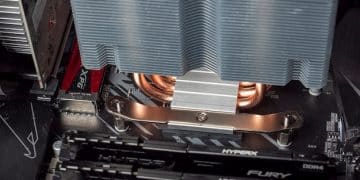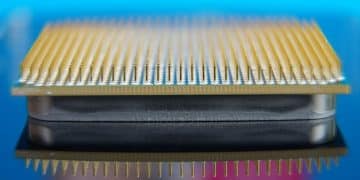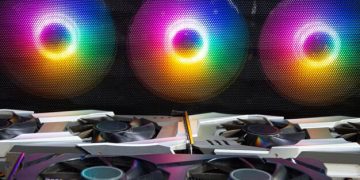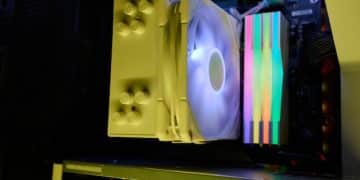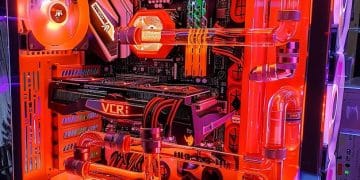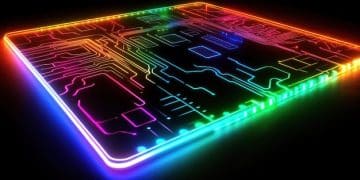Boost FPS by 30% with 2025 RAM Upgrade Strategies
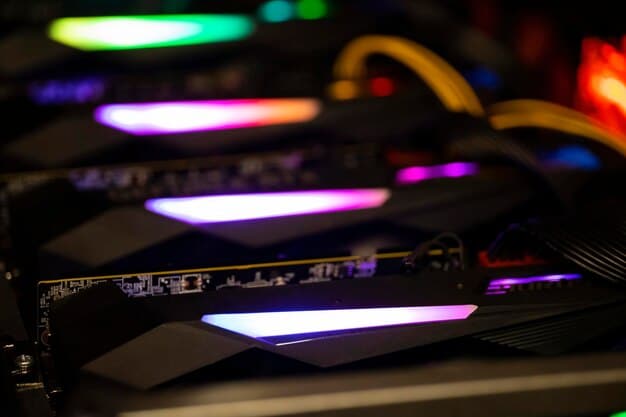
Achieving a 30% FPS increase in PC gaming is often attainable through strategic RAM upgrades, provided existing memory is a bottleneck and new modules offer faster speeds, tighter timings, or greater capacity optimally utilized by modern games and hardware architectures, especially when combined with proper system tuning and complementary component upgrades that leverage the improved memory bandwidth.
Are you looking to significantly enhance your gaming experience? While many focus on GPUs and CPUs, optimizing your system’s Random Access Memory (RAM) can unlock substantial performance gains. This article delves into how to boost your FPS by 30% with these RAM upgrade strategies for 2025, offering actionable insights for gamers aiming for peak performance.
understanding RAM and its impact on gaming
Understanding the role of RAM is fundamental before considering any upgrades. While graphics cards (GPUs) handle the heavy lifting of rendering frames, and the central processing unit (CPU) orchestrates operations, RAM acts as a crucial high-speed temporary storage for data actively used by your system and games. It’s where your operating system, running applications, and the current game data reside, enabling quick access for the CPU and GPU.
A common misconception is that simply having more RAM guarantees better performance. While sufficient RAM capacity is essential to prevent system slowdowns caused by swapping data to slower storage, exceeding the requirements for your typical workload offers diminishing returns for frame rates. The true performance differentiator lies in RAM speed, measured in MHz, and timings, which represent the latency of data access. Faster RAM, characterized by higher MHz and lower CAS Latency (CL), can significantly reduce the time it takes for your CPU to retrieve and process game assets, leading to smoother gameplay and potentially higher FPS. Modern gaming requires not just ample RAM, but also the right kind of RAM to keep pace with graphically intensive titles and complex game engines.
capacity vs. speed vs. timings: what matters most?
When evaluating RAM for gaming, the interplay between capacity, speed, and timings is critical. Capacity refers to the amount of memory available, typically 8GB, 16GB, or 32GB for gaming. Speed, expressed in MT/s (mega transfers per second) or MHz, indicates how quickly data can be transferred. Timings, like CL, dictate the latency or delay before data can be accessed.
* Capacity: For most games in 2025, 16GB of RAM is generally the sweet spot, allowing comfortable multitasking and preventing stuttering. 32GB provides more headroom for demanding titles, streaming, or content creation while gaming. Less than 16GB can be a bottleneck.
* Speed: This is arguably the most impactful factor for FPS once adequate capacity is met. DDR4 RAM starting from 3200MHz to 3600MHz offers excellent value, while DDR5 (the current standard for new builds) benefits greatly from speeds of 5600MHz to 6400MHz or higher. The faster the memory, the quicker game assets load and are accessible to the CPU.
* Timings: Lower timings are better, indicating less delay. For example, CL16 at 3200MHz is preferable to CL18 at the same speed. Tighter timings, especially when combined with high speeds, contribute to a more responsive system.
The optimal balance often depends on your CPU. AMD Ryzen processors, for instance, tend to benefit more from faster RAM speeds due to their Infinity Fabric architecture, while Intel CPUs are also positively impacted, though sometimes to a slightly lesser extent depending on the generation. Investing in RAM that offers a good balance of speed and timings, rather than just raw capacity, is key for maximizing gaming performance. This foundational understanding sets the stage for selecting the right upgrade path.
evaluating your current RAM setup
Before diving into purchasing new RAM, it’s imperative to thoroughly evaluate your existing memory configuration. This assessment will not only inform your upgrade decisions but also help identify potential bottlenecks you might not have considered. Begin by determining your current RAM’s capacity, speed, and timings. Tools like CPU-Z or simply checking your system’s Task Manager on Windows can provide this information. Knowing what you currently have is the first step towards understanding what you need.
identifying bottlenecks and upgrade potential
A common misconception is that a low frame rate automatically points to the GPU. While often true, RAM can also be a silent culprit, especially in modern gaming. If you’re experiencing micro-stutters, texture pop-in, or consistently lower FPS than benchmarks suggest for your CPU/GPU combo, RAM could be a limiting factor. Games constantly load and unload assets from RAM; if your memory isn’t fast enough, or if its capacity is insufficient, the CPU might spend more time waiting for data, leading to performance dips.
* Low Capacity: Below 16GB (e.g., 8GB) is a significant bottleneck for many contemporary games, especially at higher settings. Upgrading to 16GB or 32GB is often the most direct path to improvement.
* Slow Speed: If your RAM is running at 2400MHz or 2666MHz, particularly with a modern CPU, an upgrade to 3200MHz (DDR4) or 5600MHz+ (DDR5) can yield noticeable FPS gains.
* Poor Timings: High CL values (e.g., CL19 or CL20 for DDR4) can introduce latency. While less impactful than speed or capacity, optimizing timings can provide minor but appreciable improvements.
Consider your motherboard’s capabilities. Each motherboard has a maximum supported RAM speed and capacity. Consult your motherboard’s manual or manufacturer’s website to ensure compatibility with potential upgrades. Overlooking this crucial step could lead to purchasing incompatible RAM. Furthermore, check the number of available RAM slots. If all slots are occupied but you wish to increase capacity or speed, you might need to replace your existing modules entirely rather than just adding more.
diagnosing RAM-related performance issues
Pinpointing whether RAM is truly your bottleneck requires some diagnostic work. Running performance monitoring software while gaming, such as MSI Afterburner (which can monitor RAM usage in real-time), can offer valuable insights. Pay attention to RAM usage levels; if they consistently approach or exceed your total capacity, or if you observe disk activity spikes (indicating data being swapped to the page file), an upgrade is warranted. For example, if a game claims 12GB of RAM and you only have 8GB, your system will resort to using slower storage, causing stutters.
Comparing your in-game FPS to benchmarks for systems with identical CPUs and GPUs but different RAM configurations can also be illuminating. If you’re consistently falling short, and memory usage is high, it strongly points to RAM as a limiting factor. Identifying these issues early can save you from spending money on other components that won’t address the core problem. This careful analysis ensures that your RAM upgrade is a targeted, effective measure instead of a shot in the dark, leading to tangible improvements in your gaming experience.
choosing the right RAM for 2025
Selecting the appropriate RAM in 2025 involves navigating the evolving landscape of memory technology, primarily the transition from DDR4 to DDR5. Your choice will largely depend on your existing system’s compatibility and your budget. DDR5 is the newer, faster standard, offering significant bandwidth improvements over DDR4, but it is only compatible with motherboards and CPUs designed for it, such as Intel’s 12th generation (and newer) and AMD’s AM5 platform.
DDR4 vs. DDR5: the evolution of gaming memory
The fundamental difference between DDR4 and DDR5 lies in their architecture, leading to vastly different performance characteristics. DDR5, launched in late 2021, brings several advancements crucial for future gaming:
* Higher Speeds: DDR5 starts at 4800MHz and can reach 8000MHz or more, significantly outperforming DDR4’s typical range of 2400MHz to 4400MHz. This higher frequency bandwidth is vital for data-intensive applications and games.
* Improved Efficiency: DDR5 operates at a lower voltage (1.1V vs. DDR4’s 1.2V), contributing to better power efficiency.
* Increased Density: DDR5 allows for higher module capacities, with single sticks reaching up to 128GB, though 16GB and 32GB modules remain the most common for consumer use.
* On-die Error Correction Code (ODECC): This feature enhances stability and error resilience, a notable improvement over DDR4.
For gamers building new systems in 2025, DDR5 is the obvious choice due to its future-proofing and superior performance. However, if you’re upgrading an existing DDR4 system, migrating to DDR5 would require a new motherboard and potentially a new CPU, making it a more substantial and costly upgrade. In such cases, optimizing your DDR4 setup with faster modules might be more pragmatic. The market is increasingly shifting towards DDR5, making it the long-term standard for high-performance computing.
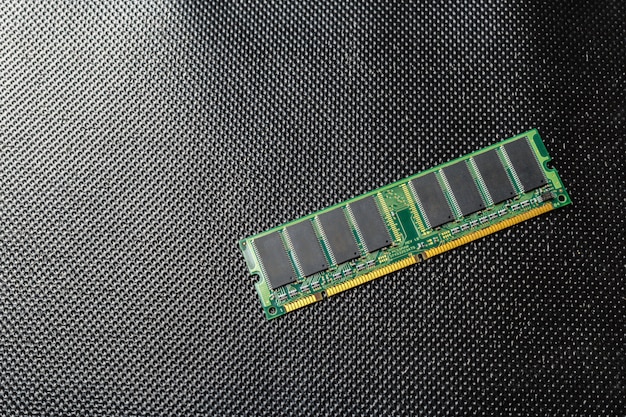
recommended specifications for different budgets
Choosing RAM involves balancing performance and cost. Here are some recommendations for 2025, categorized by typical gamer budgets:
* Entry-Level/Budget-Friendly (DDR4): If you’re on a tight budget and have a DDR4 system, target a 16GB (2x8GB) kit at 3200MHz CL16. This offers a good balance of speed and capacity for most games without breaking the bank. Avoid single sticks of RAM; dual-channel significantly boosts performance.
* Mid-Range (DDR4 or DDR5): For DDR4 systems, consider 32GB (2x16GB) at 3600MHz CL18 or CL16 for optimal performance. If you have a DDR5-compatible system, a 32GB (2x16GB) kit at 5600MHz CL36 or 6000MHz CL30 provides excellent value and performance for most gaming scenarios.
* High-End/Enthusiast (DDR5): For those seeking maximum performance, 32GB (2x16GB) or 64GB (2x32GB) DDR5 kits at 6400MHz CL32 or higher offer top-tier speeds and capacities. These highly optimized kits come with a premium but unleash the full potential of high-end CPUs and GPUs.
Always prioritize reputable brands known for quality and reliability (e.g., Corsair, G.Skill, Crucial, Kingston). Look for kits specifically marketed for gaming, as they often come with optimized profiles (XMP/EXPO) for easy setup. Furthermore, purchasing RAM in kits (e.g., 2x8GB, 2x16GB) ensures compatibility and optimized dual-channel performance. Mixing and matching different RAM sticks (even of the same speed) can sometimes lead to instability or force all sticks to run at the slowest common denominator.
compatibility and future-proofing considerations
Ensuring compatibility is paramount. Verify your motherboard’s RAM type (DDR4 or DDR5), supported speeds, and maximum capacity. Consult its Qualified Vendor List (QVL) to check for modules tested by the manufacturer. While not strictly necessary, selecting RAM from the QVL provides an extra layer of assurance.
For future-proofing, if you’re building a new system, investing in DDR5 is the sensible choice. The platform will continue to evolve, offering improved speeds and lower latencies. For DDR4 users, consider if your current system is at the end of its upgrade cycle or if a full platform overhaul (CPU, motherboard, RAM) is imminent. An intermediate DDR4 upgrade can buy time, but a complete transition to DDR5 will eventually be necessary for access to the latest gaming technologies. This forward-thinking approach ensures your investment remains relevant for several years.
installation and configuration tips for maximum FPS
Installing new RAM is a relatively straightforward process, but proper configuration is crucial to unlock its full potential and achieve the desired FPS boost. Simply slotting in new modules isn’t enough; you need to ensure they operate at their advertised speeds, which often requires a few adjustments in your system’s BIOS/UEFI settings.
physical installation steps
Before you begin, ensure your computer is completely powered off and unplugged from the wall socket. It’s also advisable to discharge static electricity by touching a grounded metal object, such as your PC case, before handling components. Working on a clean, steady surface is recommended.
1. Open the PC case: Remove the side panel to access the motherboard.
2. Locate RAM slots: These are typically long slots near the CPU socket. If you’re replacing old RAM, unclip the retaining tabs at both ends of each stick and gently pull them out.
3. Install new RAM: Align the notch on the new RAM stick with the key in the RAM slot. Press down firmly and evenly on both ends of the stick until the retaining tabs click into place. If utilizing a dual-channel configuration (recommended for gaming), refer to your motherboard manual to identify the correct slots (often alternating slots or clearly marked). For most motherboards, using slots A2 and B2 (the second slot in each channel) is optimal for two sticks.
4. Close the PC case: Once all RAM is securely installed, reattach the side panel.
A common mistake is not applying enough pressure when inserting RAM, leading to a stick not being fully seated. This can prevent your system from booting or recognizing the full amount of RAM. Listen for the audible click of the tabs to confirm proper installation.
enabling XMP/EXPO profiles in BIOS/UEFI
After physical installation, the most critical step to achieve your RAM’s advertised speeds is enabling its Extreme Memory Profile (XMP for Intel platforms) or EXPO (Extended Profiles for Overclocking, for AMD AM5 platforms) in the BIOS/UEFI. Without this, your RAM will likely run at its base JEDEC speed (e.g., 2133MHz or 2400MHz for DDR4, 4800MHz for DDR5), which is much slower than its rated speed.
1. Enter BIOS/UEFI: Restart your computer and repeatedly press the designated key (commonly Del, F2, F10, or F12) during startup to enter the BIOS/UEFI settings.
2. Locate XMP/EXPO setting: This setting is often found under an “Overclocking,” “Ai Tweaker,” “EZ Mode,” or “Advanced Memory Settings” menu. The exact location varies by motherboard manufacturer.
3. Enable the profile: Select the XMP or EXPO profile. Many motherboards offer multiple profiles; choose the one corresponding to your RAM’s rated speed and timings.
4. Save and exit: Save the changes and exit the BIOS/UEFI. Your system will reboot.
After rebooting, verify that your RAM is running at the correct speed using Task Manager (Performance tab, Memory section) or a third-party tool like CPU-Z. If the speed is lower than expected, re-enter the BIOS/UEFI and try selecting a different XMP/EXPO profile or manually setting the frequency and timings, although profile activation is usually sufficient. Incorrectly configured RAM is a common reason for underperforming systems, so this step is vital.
optimizing other system settings for memory performance
Beyond XMP/EXPO, a few other system settings can subtly influence memory performance, though their impact on FPS is generally less dramatic than RAM speed itself.
* BIOS Updates: Ensure your motherboard BIOS is up to date. Manufacturers often release updates that improve memory compatibility and stability, especially for newer, faster RAM modules.
* Driver Updates: Keep your chipset drivers updated. These drivers facilitate communication between the CPU, motherboard, and RAM, and optimized drivers can contribute to overall system efficiency.
* Power Plan: In Windows, ensure your power plan is set to “High Performance” or “Ultimate Performance.” This prevents the system from throttling components, including RAM, to save power.
* RAM Disk (Advanced): For users with excessive RAM (32GB+), creating a RAM Disk for certain game files or temporary folders can offer extreme speed, but this is an advanced technique and not practical for most gamers or a primary way to boost FPS.
These fine-tuning steps, combined with proper physical installation and XMP/EXPO activation, ensure that your new RAM is utilized to its fullest potential, contributing significantly to a smoother and higher-frame-rate gaming experience. The synergy between hardware and software optimization is what truly maximizes performance.
synergy: RAM upgrades with other components
While a RAM upgrade can independently boost FPS, its full potential is often realized when harmonized with other key components of your gaming rig. A balanced system ensures that no single component becomes a bottleneck, allowing improvements in one area to truly shine. The interaction between RAM, CPU, and GPU is particularly critical for maximizing gaming performance.
CPU and GPU considerations
The effectiveness of your RAM upgrade is heavily dependent on your CPU and GPU. A powerful CPU, such as an Intel Core i7/i9 or an AMD Ryzen 7/9 from recent generations, can fully utilize faster RAM speeds, as it can process data more quickly when it’s supplied efficiently. Conversely, an older or lower-end CPU might not be able to leverage ultra-fast RAM to its full extent, as it could become the bottleneck itself. Similarly, a high-end GPU is more likely to benefit from a faster RAM to process textures and frame data efficiently, especially at higher resolutions and settings where the GPU is heavily loaded.
* CPU: AMD Ryzen CPUs, particularly those from the Zen 2 architecture onwards, exhibit significant performance scaling with faster RAM due to the sensitivity of their Infinity Fabric interconnect to memory clock speeds. Intel CPUs also benefit, though historically, the gains might be less pronounced compared to Ryzen in some scenarios. Ensure your CPU can genuinely utilize the higher bandwidth provided by faster memory.
* GPU: While RAM doesn’t directly interact with GPU VRAM, system RAM handles game assets and instructions that the CPU feeds to the GPU. Faster system RAM can ensure the CPU keeps the GPU well-fed with data, preventing “CPU bottlenecking” scenarios where the GPU is waiting for the CPU. This is especially true in CPU-bound games or at lower resolutions where the GPU has spare capacity.
An ideal scenario involves a balanced configuration where RAM, CPU, and GPU are all performing optimally relative to each other, preventing any single component from holding back the others. Upgrading RAM without considering these interactions might lead to suboptimal results if another component is severely limiting performance.
optimizing storage and cooling for overall system health
Beyond the core trinity of RAM, CPU, and GPU, other components play a supportive but crucial role in overall system performance, especially post-RAM upgrade. Optimal storage and effective cooling ensure that your system runs smoothly and consistently, preventing thermal throttling or data access bottlenecks.
* Storage: While an NVMe SSD doesn’t directly impact in-game FPS once a game is loaded into RAM, it dramatically reduces loading times for games and levels. Upgrading from a slower SATA SSD or, worse, a hard disk drive (HDD) to a fast NVMe drive provides a noticeable quality-of-life improvement, making your gaming experience snappier. A speedy SSD also helps prevent stuttering if your RAM capacity is marginally low and the system needs to quickly swap data to the page file.
* Cooling: Faster RAM can sometimes generate more heat, particularly if you enable XMP/EXPO profiles or engage in manual overclocking. Adequate cooling for your CPU and GPU is paramount to prevent thermal throttling, which can negate any performance gains from a RAM upgrade. Ensure good airflow within your case, and consider an aftermarket CPU cooler if your stock one struggles, especially after a system upgrade. Stable temperatures ensure all components operate at their peak clock speeds.
Considering these synergistic improvements alongside your RAM upgrade ensures a holistic approach to boosting gaming performance. A 30% FPS increase isn’t just about one component; it’s about creating an efficient and balanced ecosystem where all parts work in harmony. This comprehensive strategy maximizes your investment and provides a superior gaming experience, ready for the demands of 2025 and beyond.
troubleshooting common RAM issues
Even with careful planning and installation, issues can arise after a RAM upgrade. Recognizing and troubleshooting these common problems can save you considerable frustration and help ensure your system runs smoothly at its full potential. From initial boot failures to in-game instability, a systematic approach to diagnosis is key.
system instability and crashes
One of the most common issues after a RAM upgrade is system instability. This can manifest as:
* Boot failures: Your PC might not POST (Power-On Self-Test) at all, or it might enter a continuous reboot loop with no display.
* Blue Screen of Death (BSOD): Windows might crash with various error codes, often related to memory management.
* Application crashes: Specific games or programs might crash unexpectedly, especially under heavy load.
* In-game stuttering or freezing: Erratic performance despite seemingly sufficient FPS.
These problems often stem from incompatible RAM, faulty modules, or issues with XMP/EXPO profiles. The first step is to revert to known good settings. If you enabled XMP/EXPO, disable it in the BIOS/UEFI and see if the system becomes stable at base RAM speeds. If so, try enabling the profile incrementally, or select a different, perhaps slightly slower, XMP/EXPO profile. Sometimes, manual tuning of voltages or timings is required, but this is an advanced step.
diagnosing RAM errors with memtest86
When instability persists, a dedicated memory diagnostic tool like MemTest86 is invaluable. MemTest86 is a powerful, free, and open-source memory test program that runs from a bootable USB drive, completely independent of your operating system. This isolation allows it to thoroughly test your RAM for errors that might not be apparent during normal use.
* Create a bootable USB: Download MemTest86 from its official website and use software like Rufus to create a bootable USB stick.
* Boot from USB: Restart your PC and set your BIOS/UEFI to boot from the USB drive.
* Run the test: MemTest86 will automatically start the testing process. Allow it to run for several passes (at least 4 to 8, or ideally overnight) to ensure a comprehensive test. Even a single error detected indicates a problem.
If MemTest86 reports errors, it strongly suggests a faulty RAM stick. If you have multiple sticks, test them individually to pinpoint the defective module. Remove all but one stick and run MemTest86, then repeat for each stick. This helps identify if one specific module is causing the issue. A faulty stick will need to be replaced, ideally under warranty.
resolving compatibility issues
Compatibility issues can be tricky. Even if technically correct (e.g., DDR4 RAM in a DDR4 slot), specific modules might not play well with certain motherboards or CPUs, especially when attempting higher frequencies.
* Check motherboard QVL: As mentioned before, consulting your motherboard’s Qualified Vendor List (QVL) is crucial. If your RAM isn’t on the QVL, it doesn’t mean it won’t work, but it means the manufacturer hasn’t formally tested it, and compatibility might not be guaranteed at high speeds.
* BIOS updates: Ensure your motherboard has the latest BIOS/UEFI firmware. Manufacturers frequently release updates that improve RAM compatibility and stability, especially for newer modules or higher speeds.
* Voltage adjustments: In some cases, manual adjustment of RAM voltage (VDIMM) or System Agent/VCCIO voltage (for Intel) or SOC voltage (for AMD) in the BIOS/UEFI can stabilize high-speed RAM. However, this should only be done with caution and after consulting reputable guides, as incorrect voltages can damage components. Start with small increments (e.g., +0.05V) based on online recommendations for your specific RAM and motherboard.
* Return/Exchange: If all troubleshooting steps fail, and you’ve confirmed the RAM is faulty or incompatible, your best option is to return or exchange the modules. Purchase from retailers with good return policies.
Troubleshooting RAM issues requires patience and a methodical approach. By systematically eliminating potential causes, you can diagnose and resolve most common problems, ensuring your RAM upgrade delivers the performance boost you aimed for without frustrating setbacks.
future-proofing your RAM for upcoming games
As gaming technology relentlessly advances, anticipating future requirements for RAM is a smart move for any enthusiast. Investing in components that offer a degree of future-proofing ensures your system remains competitive for longer, minimizing the need for frequent, costly upgrades. For RAM, this means considering not just today’s demands but also the projected needs of games in 2025 and beyond.
DDR5 and beyond: what’s next for memory?
DDR5 is currently the cutting edge of consumer RAM technology, but it’s just the beginning. The industry is already looking towards future generations, driven by an insatiable demand for higher bandwidth and lower latency. While a full transition to DDR6 or similar high-performance memory is likely several years away for the mainstream market, DDR5 itself will continue to evolve.
* Higher Speeds and Tighter Timings: Expect DDR5 modules to reach even higher frequencies (e.g., 8000MHz to 10000MHz+) with more optimized timings as manufacturers refine their processes.
* Increased Density: Higher capacity modules will become more common and affordable, catering to the ever-growing memory footprints of games and productivity applications.
* Emerging Technologies: Research into other memory types, such as HBM (High Bandwidth Memory), traditionally used in GPUs and high-performance computing, might eventually trickle down to consumer CPUs or specialized gaming hardware, although not likely to replace DDR5 for mainstream system RAM in the immediate future.
For gamers in 2025, investing in a robust DDR5 setup (e.g., 32GB at 6000MHz+ CL30) is the most effective way to future-proof their RAM. This configuration should comfortably handle upcoming titles for several years.
the evolving demands of game engines and resolutions
Game developers are constantly pushing the boundaries of realism, which translates directly into higher hardware demands. Modern game engines are designed to leverage available resources, including RAM, more efficiently.
* Larger Worlds and Assets: Open-world games and highly detailed environments require vast amounts of data to be loaded into memory. As game worlds become more expansive and texture fidelities increase, the demand for sufficient RAM capacity will only grow. 16GB is currently standard, but 32GB is rapidly becoming the recommended minimum for enthusiast-level gaming, especially when running games at higher resolutions (1440p, 4K) or with demanding graphical settings.
* Ray Tracing and Path Tracing: Advanced rendering techniques like ray tracing and, increasingly, path tracing, significantly increase the complexity of scenes and the amount of data processed per frame. While primarily GPU-bound, these technologies can also increase the workload on the CPU and system RAM, as more complex scene data needs to be fed to the GPU.
* Multitasking and Streaming: Many gamers also stream their gameplay, record content, or run multiple applications simultaneously. These activities compound the memory requirements, making higher capacity RAM (32GB+) practically a necessity for a smooth experience without performance degradation.
Anticipating these trends means choosing RAM that not only meets current needs but also provides ample headroom for the future. Overlooking this can lead to needing another RAM upgrade sooner than expected, underscoring the importance of making an informed decision today. Building a system that can adapt to the future demands of gaming ensures that your hardware remains a capable platform for years to come.
RAM Upgrade Strategies for 2025: Key Takeaways
| Key Aspect | Brief Description |
|---|---|
| 🚀 Prioritize Speed & Timings | Beyond capacity, faster MHz and lower CL timings are crucial for FPS gains, especially for modern CPUs and games. |
| 🔄 DDR4 vs. DDR5 & Compatibility | DDR5 is for new builds; optimize DDR4 systems with 3200MHz+ CL16. Always check motherboard compatibility (QVL). |
| 🔧 Enable XMP/EXPO | Crucial BIOS setting to unlock advertised RAM speeds; without it, RAM runs at slower base clock. |
| ⚖️ System Synergy & Future-Proofing | Pair RAM with capable CPU/GPU. Consider 32GB DDR5 for high-end gaming as standard evolves. |
frequently asked questions about RAM upgrades
▼
A 30% FPS boost from a RAM upgrade is achievable, but it’s situational. It primarily occurs if your existing RAM is a significant bottleneck, such as upgrading from 8GB to 16GB, or from very slow DDR4 to high-speed DDR4/DDR5. The exact increase varies greatly depending on the game, your CPU, and GPU, and is more likely in CPU-intensive games.
▼
For most dedicated gamers in 2025, 16GB of fast RAM (e.g., DDR4 3600MHz CL16 or DDR5 6000MHz CL30) is sufficient. However, 32GB provides greater headroom for future titles, multitasking (like streaming), and prevents any potential slowdowns from memory swapping, making it the preferred choice for enthusiasts seeking optimal results.
▼
XMP (Extreme Memory Profile for Intel) and EXPO (Extended Profiles for Overclocking for AMD) are pre-configured settings stored on RAM modules. They allow your motherboard to automatically configure RAM to its advertised, higher speeds and timings beyond the basic JEDEC standards. Enabling these profiles in BIOS is crucial to unlock your RAM’s full performance potential.
▼
While technically possible, mixing different RAM speeds or brands is generally not recommended. It can lead to instability or force all modules to run at the slowest common denominator (lowest speed, highest latency). For optimal performance and stability, always use matched kits (identical brand, model, speed, and capacity) bought together.
▼
RAM upgrades are less frequent than GPU upgrades. If you have 16GB of sufficiently fast RAM, you might not need an upgrade for several years. Consider upgrading when you hit a major capacity bottleneck (e.g., 8GB struggling with new games) or when migrating to a new platform (like from DDR4 to DDR5) that offers significant inherent performance gains.
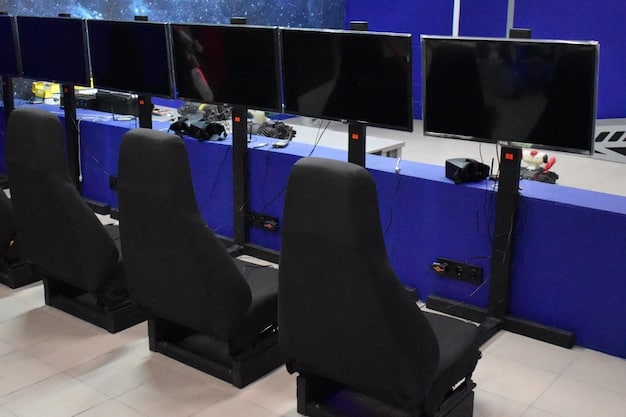
conclusion
Optimizing your system’s RAM is a surprisingly impactful way to enhance your gaming experience. While often overshadowed by CPU and GPU upgrades, proper RAM selection and configuration can provide tangible benefits, potentially contributing to a significant FPS boost and overall smoother gameplay. By understanding the interplay of capacity, speed, and timings, evaluating your current setup, and diligently configuring your new modules via XMP/EXPO, you can unlock previously untapped performance. As gaming continues to evolve, staying ahead means not just having powerful components, but ensuring they work in perfect harmony. Embracing the right RAM upgrade strategies for 2025 lays a strong foundation for a future-proof and exhilarating gaming journey.
